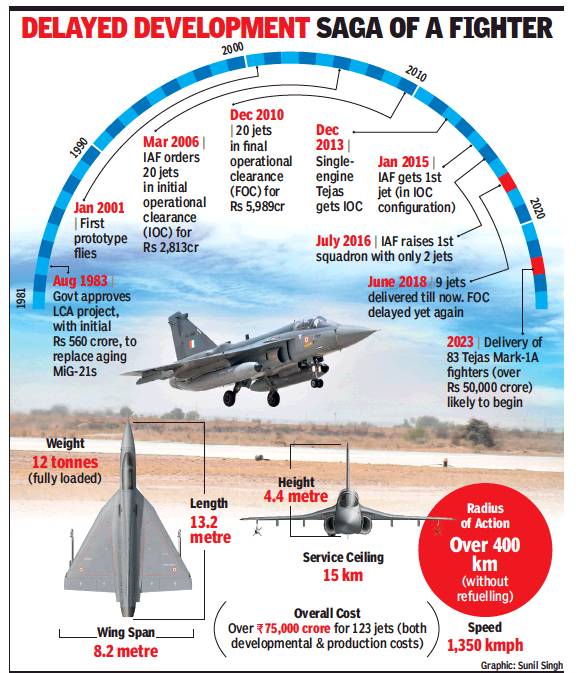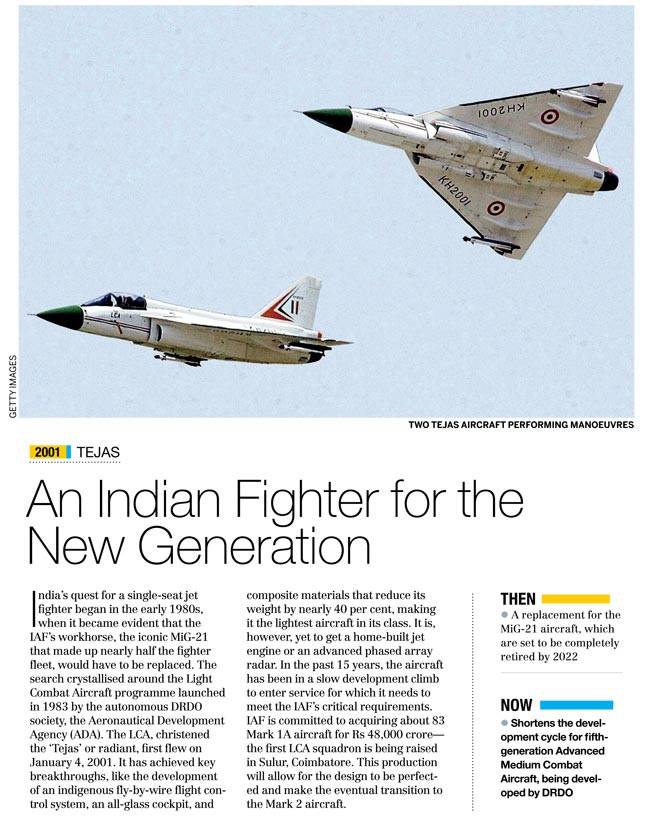Light Combat Aircraft (LCA):India
This is a collection of articles archived for the excellence of their content. |
Contents |
History of Light Combat Aircraft (LCA)
1983-2014
The Times of India, December 20, 2014
See Graphic, History of the LCA: 1983-2014; targets: 2014-2022
Milestones
2001-15
The Times of India Jan 19 2015
Chethan Kumar
Over 80 trial flights to test systems cancelled in 2014
As Team Tejas burns the midnight oil to integrate new weapon systems and upgrade other capabilities on the light combat aircraft (LCA) as mandated by the Indian Air Force (IAF), bad weather has taken away many flying hours, critical for testing such systems before certification. From January 4, 2001, when wing commander Rajiv Kothiyal flew the first LCA prototype to January 17, 2015, the day the first aircraft was handed over to the IAF, 2,850 trial flights of LCA have taken place. Notwithstanding the nature of tests each of these flights carry out, ranging from weapon delivery to navigation, trial flights are crucial, senior IAF officials say.
However, Team Tejas was forced to abandon 80 scheduled flights last year, some attempting to even test the Russian Gun integrated with an LCA prototype. IAF has been pressurizing Aero nautical Development Agency (ADA) which has designed LCA to have this feature on the plane.
ADA chief PS Subramanya told TOI, “Last monsoon saw 80 of our trial flights get cancelled, making them fly this year to check its efficiency.“ Without these test flights, ADA cannot guarantee IAF of the performance, nor get certification. In 2014, a total of 350 test flights took place, about 150 less than 2013. “...A few flights also had to be postponed due to technical reasons,“ Subramanya said.
The team, currently working on integrating mid-air refuelling capabilities on Tejas, is looking at achieving more than 500 flights in 2015, with a final operational clearance for LCA expected in 2016.
About 15 LCAs lie in the hangers of HAL, including the seven Limited Series Production (LSP) aircraft, two Technology Demonstrators, three Fighter Prototypes, two Trainer Prototypes and one Naval Prototype.
2015:IAF finally receives first series
Jan 18 2015
Chethan Kumar
After a 32-year wait, the Indian Air Force (IAF) received its first series production version of the Light Combat Aircraft Tejas (LCA-SP1). Its induction into a fighting squadron, however, will take longer. The IAF, sources said, is looking to raise the first squadron with a fleet of six to eight LCAs. Given the inadequate number of aircraft, this cannot be done before 2016.
A squadron, according to a retired Air Marshal, generally comprises 18 pilots. It has a service aircraft, a standby platform and a trainer.“However, the number could vary depending on the aircraft and other variables.“
Sources said that neither the SP-1 nor the SP-2 will make it to a fighting squadron; versions from the SP-3 and later will be considered.
Hindustan Aeronautics Limited (HAL) chairman R K Tyagi, however, told STOI: “...The SP-1 has been handed over to the IAF by the defence minister. They have accepted the aircraft. Where but in the squadrons is its place?“ The SP1, which first flew in October 2014, has had only five flights and needs more hours before induction. Also, an initial operational clearance (IOC) configuration without the latest electronic warfare suite, long-range missile capabilities and mid-air refuelling means there may be further improvements required before it is finally in ducted into a squadron.
Saturday's ceremony was only symbolic, according to sources. “India can truly claim the LCA as a success only after the aircraft get commissioned into a squadron,“ the Air Marshal said. The IAF has placed an initial order of 40 aircraft, 20 of which will be in the IOC configuration. HAL can produce eight aircraft a year.
“After the second one reaches the IAF in March, the remaining six will be delivered before March 31, 2016; three out of these six will reach the IAF before June, 2015,“ Tyagi said. The cost of one SPstandard LCA could touch about Rs 160 crore, thanks to the delays; an earlier estimation was about Rs 120 crore.
Defence minister Manohar Parrikar and chief of air staff Air Chief Marshal Arup Raha were in Bengaluru for a meeting of the panel that looks into the progress of LCA. While there was no news on what happened at the closed-door meet, sources said the handing-over ceremony was squeezed into Parrikar's schedule.
2018: Tejas misses another deadline
Rajat Pandit, July 9, 2018: The Times of India

From: Rajat Pandit, July 9, 2018: The Times of India
The indigenous Tejas fighter, first approved in 1983, has missed yet another deadline to become fully combat-ready. After several target revisions, the government had repeatedly declared over the last couple of years that the jet would get its final operational clearance (FOC) by June 2018.
But the single-engine Tejas is still far away from achieving the FOC, amidst galloping costs and operational concerns, say defence ministry officials. The estimated overall development and production cost of the first 123 light-weight Tejas – only nine delivered till now in their initial operational clearance (IOC) configuration – has also zoomed past Rs 75,000 crore.
India desperately needs its own home-grown fighter, with IAF down to just 31 fighter squadrons when at least 42 are required to tackle Pakistan and China. The fall in numbers will continue due to progressive retirement of 10 squadrons of old MiG-21s and MiG-27s.
India also relaunched its Rs 1.25 lakh crore project to acquire 114 fighters, the bulk of them to be built domestically, in April. But it’s still early days for this long-drawn contest among F/A-18 and F-16 (US), Gripen-E (Sweden), MiG-35 (Russia), Rafale (France) and Eurofighter Typhoon, for which the six aviation majors submitted their initial bids last week.
Consequently, the continuing delay in Tejas remains a big operational worry. In 2011, DRDO had grandiosely announced Tejas would get FOC — which means the jets are ready for battle -- by 2012. Six years down the line, it remains a pipe dream.
“The entire project management of Tejas needs to be overhauled. Hindustan Aeronautics Ltd is far away from delivering 16 Tejas per year as required. MoD is also examining the Rs 50,000 crore being demanded by HAL for producing 83 Tejas Mark-1A fighters, with 43 improvements over the existing version,” said an official.
For now, Tejas needs to demonstrate its “engine relight and air-to-air refuelling” capabilities as well as firing from its twin-barrel GSh-23 cannon.
Though Navy has rejected its aircraft carrier-capable variant, IAF has put its weight behind Tejas. In addition to the “committed” 123 jets, it is open to inducting another 201 Tejas Mark-II jets if they are entirely new fighters with much better avionics and radars, enhanced fuel and weapons carrying capacity, and more powerful engines, as earlier reported by TOI.

